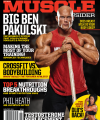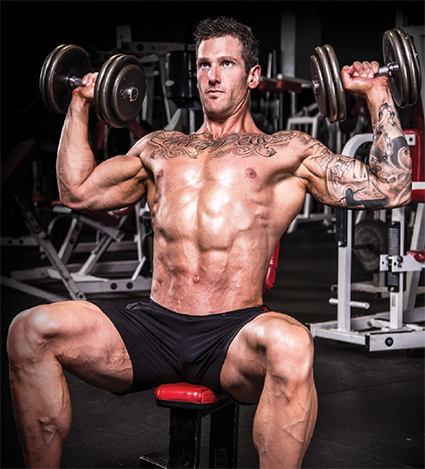Full-Body Training For Full Mass Gains
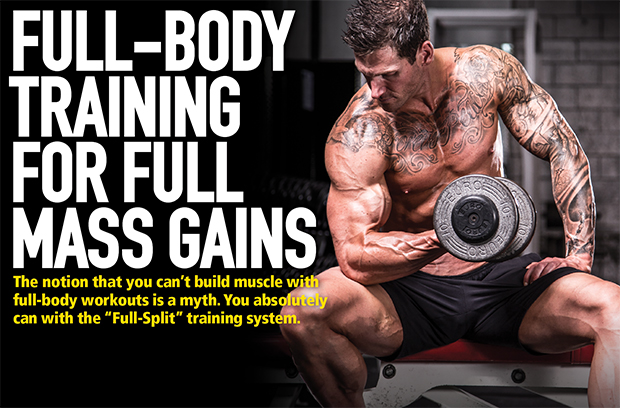
The notion that you can’t build muscle with full-body workouts is a myth. You absolutely can with the “Full-Split” training system.
When it comes to selecting a training split that will help you build muscle, you may think your options are limited to some variation of a three- to seven-day split where no more than two or three body parts are trained per workout and muscle groups are worked no more than twice a week.
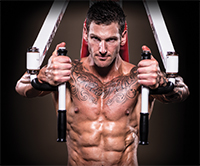 By this logic, full-body training (where all major muscle groups are hit in all workouts) would be completely out of the question, reserved only for beginners, CrossFitters, and boot camp classes. Right? I say wrong.
By this logic, full-body training (where all major muscle groups are hit in all workouts) would be completely out of the question, reserved only for beginners, CrossFitters, and boot camp classes. Right? I say wrong.
I’ve been prescribing full-body workouts for JimStoppani.com members as well as my social media followers for years now, and not only because this style of training is best for fat loss. Full-body training can also be highly effective for building muscle, even when all body parts are trained five or more days in a row (as they are in nearly all of my recent programs).
Don’t believe me? My physique and those of thousands of my followers are living proof that you can get leaner and bigger with full-body workouts. This may fly in the face of bodybuilding wisdom, but when done correctly and systematically—namely, with my new “Full-Split” training system—full-body training can be a great method for anyone looking to add size.
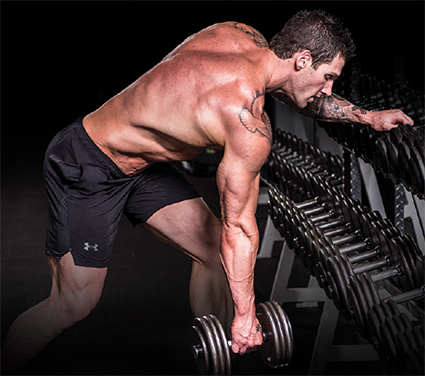
The Problem with Full-Body Training
Let’s first discuss the downfalls of traditional full-body training as it pertains to building muscle.
Most full-body workouts consist of doing one exercise per major group anywhere from three to six days per week. There’s nothing inherently wrong with this model, but for the guy looking to truly maximize size gains, there are two issues here: (1) a lack of pump and (2) a lack of fatigue in any particular muscle group. These are two critical aspects of building size.
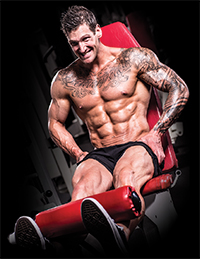 The muscle pump isn’t just a temporary thing that looks and feels good when you’re at the gym—it’s actually the muscle cells filling up with water. When you train, waste products build up in the muscle cells as a result of your body burning glucose and fat to fuel muscle contractions. This buildup in waste products draws in water to feed the muscles. Just like a balloon, the more water the muscle cell can hold, the bigger the pump. The pump essentially places a stretch on the muscle cell. This stretch not only makes muscles momentarily bigger but also initiates biochemical pathways that signal the muscle cell to grow.
The muscle pump isn’t just a temporary thing that looks and feels good when you’re at the gym—it’s actually the muscle cells filling up with water. When you train, waste products build up in the muscle cells as a result of your body burning glucose and fat to fuel muscle contractions. This buildup in waste products draws in water to feed the muscles. Just like a balloon, the more water the muscle cell can hold, the bigger the pump. The pump essentially places a stretch on the muscle cell. This stretch not only makes muscles momentarily bigger but also initiates biochemical pathways that signal the muscle cell to grow.
As for muscle fatigue, you won’t grow without it, which is why I’m such a big proponent of training to failure on sets; that’s how you maximize fatigue. And while taking, say, 3 sets to failure for a given muscle group can help you build muscle, that probably won’t provide enough fatigue to truly maximize hypertrophy. To do this, you need to bump up the volume (total number of sets per muscle group) not just over the course of the week, but in individual workouts. There’s a reason why bodybuilders train a muscle group with high volume (e.g., 15+ sets) in a workout: because it works for getting bigger.
The Full-Split System: Beefing Up Full-Body Training
So, do full-body workouts need to be avoided entirely to maximize size? Absolutely not. I created the Stoppani Full-Split system (SFS for short) to deliver the best of both worlds: full-body workouts for optimal fat loss combined with body part-split training to maximize hypertrophy (muscle growth).
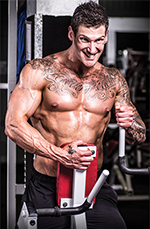 With the Full-Split system, all major muscle groups are trained in every workout, usually five or six days per week, but each workout has two or three “focus” muscle groups. The focus muscle groups get anywhere from two to five exercises each (two exercises for smaller muscle groups such as traps and forearms, four or five exercises for larger body parts such as chest, back, and legs), and all other muscle groups in the workout get just one exercise.
With the Full-Split system, all major muscle groups are trained in every workout, usually five or six days per week, but each workout has two or three “focus” muscle groups. The focus muscle groups get anywhere from two to five exercises each (two exercises for smaller muscle groups such as traps and forearms, four or five exercises for larger body parts such as chest, back, and legs), and all other muscle groups in the workout get just one exercise.
For example, my Down and Up Mass Full-Split training program on JimStoppani.com calls for five workouts per week. Each workout has two or three “focus” muscle groups, and each of 10 body parts gets added focus/volume once a week. Here’s how the weekly training split looks:
Day 1: Chest and Abs focus (4 chest exercises, 2 ab exercises)
Day 2: Back and Calves focus (4 back exercises, 2 calf exercises)
Day 3: Shoulders, Traps, Abs focus (4 shoulder exercises, 2 traps exercises, 2 abs exercises)
Day 4: Triceps, Biceps, Forearms focus (3 triceps exercises, 3 biceps exercises, 2 forearm exercises)
Day 5: Legs and Calves focus (5 leg exercises, 2 calf exercises)
In parentheses, you see how many exercises are performed for the focus muscle groups. All other seven or eight muscle groups in each workout get one exercise per. With this plan, you’re essentially combining full-body training with a five-day body part split. There’s a reason that “Mass” is in the name of the program: because it’s a true muscle-building routine.
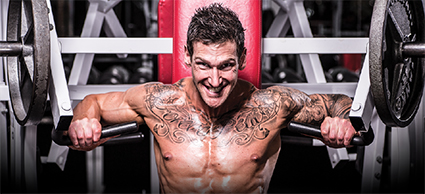
The Overtraining Myth
When I discuss my Full-Split system and how it can work to maximize muscle growth while also spurring fat loss, you may be thinking, “Don’t muscles need 48 to 72 hours of full recovery in order to grow? How can you get bigger training every muscle group five days a week? Isn’t that overtraining?”
 The truth is, overtraining isn’t as common as many people believe, except in very high-level athletes training and practicing several times a day. The human body is designed to work all day long. Even the toughest, longest workouts you do probably aren’t enough to send your body into a state of overtraining. Even if it did occur, the overtraining often tends to be because of inadequate nutrition, not overly extreme training. Eat enough to fuel your workouts and the recovery from those workouts, and there should be no risk of overtraining.
The truth is, overtraining isn’t as common as many people believe, except in very high-level athletes training and practicing several times a day. The human body is designed to work all day long. Even the toughest, longest workouts you do probably aren’t enough to send your body into a state of overtraining. Even if it did occur, the overtraining often tends to be because of inadequate nutrition, not overly extreme training. Eat enough to fuel your workouts and the recovery from those workouts, and there should be no risk of overtraining.
As far as adequate recovery between workouts goes, training a muscle the day after a grueling workout won’t impede recovery of that body part. When muscle fibres become damaged, they gain a protective mechanism that prevents them from further damage. Essentially, they go dormant until the muscle cell has recovered, so any extra work the next day won’t actually use those “aged” muscle fibres; rather, different fibres will be used. This can be beneficial for stimulating muscle growth, as more fibres get used. Plus, the exercise will aid recovery of the muscles.

Build Your Own Full-Split Program
With my Down and Up Mass program, I showed you an example of a Full-Split weekly schedule. But you can also build your own Full-Split routine based off what body parts you like to train together. Simply take your normal body part split, make the muscle groups for each day the “focus,” and then do one exercise for all other remaining muscle groups.
For example, let’s say your favorite training routine is a four-day split of chest and triceps on Day 1; back and biceps on Day 2; legs and calves on Day 3; and shoulders and abs on Day 4. Here’s how the Full-Split version might look:
 Day 1: Chest and Triceps focus
Day 1: Chest and Triceps focus
4 chest exercises, 3 triceps exercises, and one exercise each for all other muscle groups.
Day 2: Back and Biceps focus
4 back exercises, 3 biceps exercises, and one exercise each for all other muscle groups.
Day 3: Legs and Calves focus
5 leg exercises (including quads and hamstrings), 2 or 3 calf exercises, and one exercise each for all other muscle groups. (See below sidebar for a sample legs and calves workout.)
Day 4: Shoulders and Abs focus
4 shoulder exercises, 2 or 3 ab exercises, and one exercise each for all other muscle groups.
You also have the option here to train five days a week. If you want to do this but still retain your four-day split, you can have Day 5 train all muscle groups with only one exercise each. Or, Day 5 can target smaller muscle groups—such as traps and forearms—with two or three exercises each.
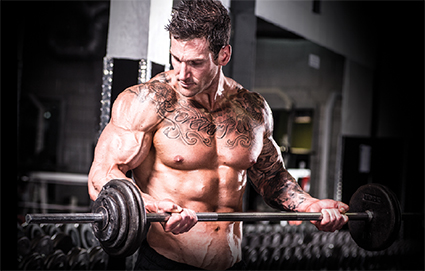
Full-Split System Sample Legs and Calves Workout
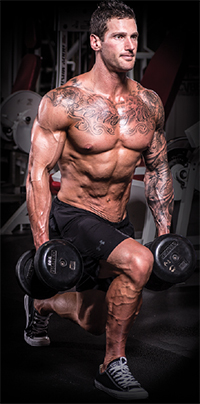 Exercise Sets Reps
Exercise Sets Reps
Deadlift 3 10–12
Walking Lunge 3 10–12
Leg Extension 3 10–12
Romanian Deadlift 3 10–12
Leg Curl 3 10–12
Bench Press 3 10–12
Barbell Bent-Over Row 3 10–12
Barbell Overhead Press 3 10–12
Barbell Shrug 3 10–12
 Standing Barbell Curl 3 10–12
Standing Barbell Curl 3 10–12
Lying Triceps Extension 3 10–12
Barbell Wrist Curl 3 10–12
Standing Calf Raise 3 10–12
Seated Calf Raise 3 10–12
Hanging Leg Raise 3 10–12
Get articles delivered to you each month by signing up to the FREE Muscle Insider newsletter. Just click here.


